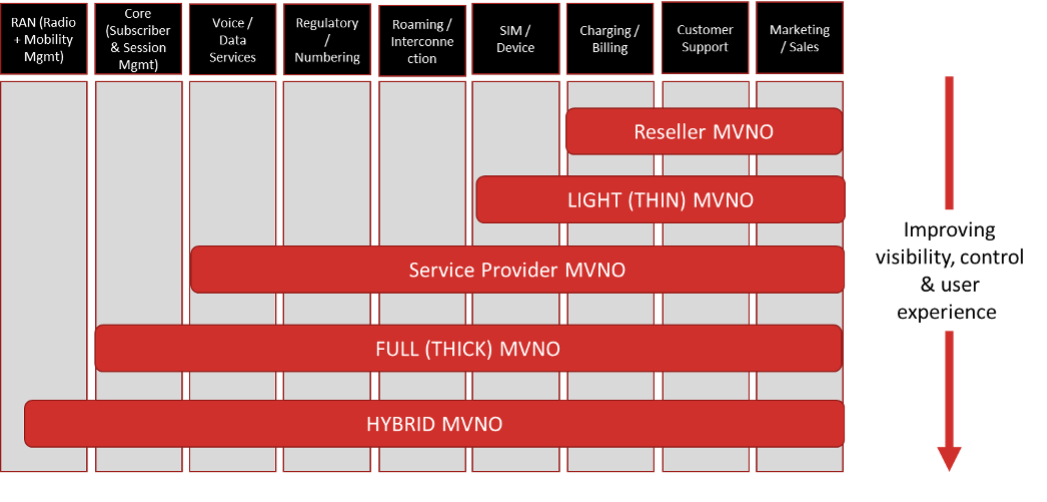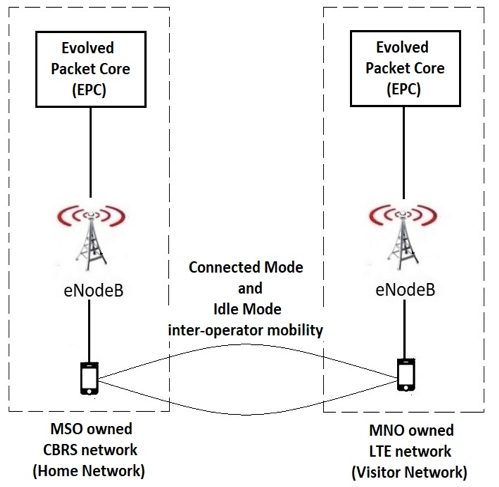Wireless
Unlocking the Power of Seamless Connectivity

Key Points
- Seamless connectivity has become of paramount importance for operators that own hybrid network infrastructures and offer varied service offerings.
- CableLabs’ Seamless Connectivity working group is focused on validating and understanding the gravity of the problem by simulating real-world scenarios in a lab environment.
- The working group is now investigating solutions that could address the seamless connectivity issues. We showcased one potential solution, ATSSS, as a demo at last week’s CableLabs Winter Conference.
Seamless connectivity is increasingly becoming an integral part of the connectivity service offerings of multiple system operators (MSOs). MSOs with their hybrid network infrastructure and varied service offerings may supplement their connectivity offerings with other wireless operators — for example, mobile virtual network operator (MVNO) agreements with mobile network operators (MNOs) — in addition to leveraging their own infrastructure. Depending on the infrastructure they own, MSOs may have to contend with disparate sets of wireless infrastructures.
In such scenarios, the transition of the user’s data traffic between these disparate networks becomes critical for ensuring a consistent user experience. It is also key to enforcing uniform and personalized policies as users move in and out of coverage of these networks with regards to:
- The transition being optimally triggered, considering not just the received signal strength indicator (RSSI) but also the network congestion, availability of and interference from neighboring networks and the traffic requirements (based on traffic/application type).
- The transition being as quick and seamless as possible (without any noticeable service disruption to the user) while maintaining security and privacy of user data.
Addressing these challenges will enable seamless and consistent connectivity for subscribers, dynamically adapting to evolving user needs and network conditions.
CableLabs’ Work In the Seamless Connectivity Space
CableLabs recognizes the evolving mobile industry landscape driven by the introduction of 5G and the availability of new and innovative spectrum options. Aware of our members’ growing mobile subscriber base and a need to complement their existing broadband offerings, we understand how critical it is to resolve the pain points that they face today (or may face in the near future).
Considering this, CableLabs, in collaboration with our members, started a Seamless Connectivity working group (WG) to understand and validate some of these issues. The aim of the group is to come up with multiple solutions that could cater to specific member needs by aligning with their infrastructure and deployment strategies. Seamless connectivity is a key theme of the Technology Vision for the future of the industry.
One potential solution for addressing the seamless connectivity issue is ATSSS, or Access Traffic Steering, Switching and Splitting. To learn more about the standardized ATSSS feature, watch our demo video below. You can watch the full video, “Harnessing ATSSS: Seamless Traffic Switching for Uninterrupted Connectivity,” here.

To learn more, check out the paper on seamless connectivity that we published at SCTE TechExpo24.
If you have any questions on the ATSSS demo or seamless connectivity initiative or if you would like to participate in the working group and collaborate with us, please reach out to me or my colleagues Sanjay Patel, John Bahr and Neeharika Jesukumar.
Convergence
Introducing Evolved Mobile Virtual Network Operator (MVNO) Architectures for Converged Wireless Deployments

As smartphones and tablets continue to proliferate, seamless connectivity is becoming an integral part of a wireless operator’s service offering—as well as a competitive imperative. Recognizing the evolution of the mobile industry landscape, and driven by the introduction of 5G and the availability of new and innovative spectrum options, CableLabs and its members initiated a technical working group (Dec. 2020-Aug. 2021) to create an evolved architectural blueprint for mobile virtual network operators (MVNOs). The working group’s aim was to explore new converged architectures that will benefit our members’ wireless deployments while highlighting the benefits, impacts to existing deployments and features needed to be supported by both mobile network operator (MNO) and MVNO networks.
Background
Many traditional broadband services providers—also known as multiple system operators (MSOs)—might not own mobile infrastructure but have (or are in the process of negotiating) MVNO arrangements with MNOs. These kinds of arrangements allow them to bundle fixed and mobile broadband services into a single service package. Traditionally, most MSOs adopt a reseller-type “Wi-Fi first” MVNO, where the MVNO doesn’t own any mobile network infrastructure and resells the services leveraging MNO infrastructure.
Emergence of a New MVNO Model

The MVNO models vary based on the amount of mobile network infrastructure that the MVNO owns and the degree of control over the management of different aspects of MVNO subscriptions and their service offerings. One common aspect of all traditional MVNO models is leveraging the radio access network (RAN) of a partner MNO.
With the advent of 5G and the availability of shared spectrum, many MSOs are actively evaluating offload opportunities for enhancing MVNO economics and are contemplating deploying their own mobile radio infrastructure in specific geographic areas (in addition to their substantial Wi-Fi footprint).
Such MSOs now have to contend with three disparate sets of wireless infrastructures:
- the MSO’s community Wi-Fi network,
- the MNO’s 4G/5G network, and
- the MSO’s own 4G/5G network.
This creates a new type of MVNO model called hybrid-MVNO (H-MVNO) that enables MVNOs to offload their subscribers’ traffic from the MNO network—not just to their Wi-Fi networks but also to the MVNO-owned mobile network when inside the coverage footprint of their wireless network(s).
Maximizing data offload via the H-MVNOs’ own wireless assets—thus ensuring a consistent user experience and enforcing uniform and personalized policies as users move in and out of coverage of these three networks—will require the deployment of new converged network architecture and related capabilities.
Dual-SIM Architectures Evaluated by the Technical Working Group
Leveraging dual-SIM devices (devices with the ability to simultaneously connect to two networks) to realize this network convergence is the one way for an H-MVNO to maximize the use of its own network. Dual-SIM device usage allows the H-MVNO to leverage the existing reseller-type MVNO arrangements and require minimum interaction between the H-MVNO and MNO core networks.
However, leveraging the reseller MVNO with dual-SIM capabilities doesn’t offer the H-MVNO any real-time insights into their subscribers’ data usage statistics and patterns. Also, H-MVNOs have no control over policy, subscriptions, mobility or user experience management when their subscribers are outside H-MVNO network coverage.
This formed the basis of evaluating the new evolved Dual-SIM Dual Standby (DSDS) architectures, which leverage standardized 3GPP interfaces to overcome some of the limitations of the traditional reseller MVNO and provide more control to H-MVNOs with regard to policy, subscription and user-experience management by anchoring all subscriber data traffic in a common anchor within the H-MVNO network.
Voice handling with dual-SIM devices can be simplified by leveraging the MNO SIM and network for carrying voice traffic at all times, while prioritizing H-MVNO network (when available) for data traffic.
Single-SIM Architectures Evaluated by the Technical Working Group
Unlike architectures with dual SIMs, single-SIM devices allow the H-MVNO network to enable seamless low-latency mobility for data applications across the MNO and H-MVNO networks. An ideal architecture for offering mobile services with single-SIM device usage is to combine the roaming architecture and a mobility interface, both of which are standardized in 3GPP.
However, due to the targeted nature of H-MVNO mobile deployments, the signaling load can increase on MNO mobility management core network elements, as the H-MVNO subscribers move in and out of H-MVNO network coverage.
To overcome this problem, we evaluated new MVNO architectures that make use of dedicated network elements within the MNO domain to serve H-MVNO subscriber traffic, thereby isolating it from the MNO subscriber traffic and eliminating the increase in signaling load on core network elements that serve MNO subscribers.
In addition, we evaluated voice handling in scenarios where H-MVNOs don’t want to deploy their own voice platforms. One option is to offer voice via a third-party voice service provider; another is to enable additional interfaces between the MNO and the H-MVNO network to leverage the MNO’s voice platform.
Go Deeper
If you have any further questions, please feel free to reach out to the MVNO Interconnect Technical WG Lead, Omkar Dharmadhikari (o.dharmadhikari@cablelabs.com).
For more information, please visit:
- Mobile Summit Session #2 MVNOs (November 2020)
- MVNO Interconnect Phase 1 White Paper (May 2021)
- Evolved MVNO Architectures for Converged Wireless Deployments paper and presentation at SCTE Expo 2021 (October 2021)
- CableLabs Webinar on Evolved MVNO Architectures for Converged Wireless Deployments (October 2021)

AI
Leveraging Machine Learning and Artificial Intelligence for 5G

The heterogenous nature of future wireless networks comprising of multiple access networks, frequency bands and cells - all with overlapping coverage areas - presents wireless operators with network planning and deployment challenges. Machine Learning (ML) and Artificial Intelligence (AI) can assist wireless operators to overcome these challenges by analyzing the geographic information, engineering parameters and historic data to:
- Forecast the peak traffic, resource utilization and application types
- Optimize and fine tune network parameters for capacity expansion
- Eliminate coverage holes by measuring the interference and using the inter-site distance information
5G can be a key enabler to drive the ML and AI integration into the network edge. The figure below shows how 5G enables simultaneous connections to multiple IoT devices generating massive amounts of data. The integration of ML and AI with 5G multi-access edge computing (MEC) enables wireless operators to offer:
- High level of automation from the distributed ML and AI architecture at the network edge
- Application-based traffic steering and aggregation across heterogeneous access networks
- Dynamic network slicing to address varied use cases with different QoS requirements
- ML/AI-as-a-service offering for end users

ML and AI for Beamforming
5G, deployed using mm-wave, has beam-based cell coverage unlike 4G which has sector-based coverage. A machine learned algorithm can assist the 5G cell site to compute a set of candidate beams, originating either from the serving or its neighboring cell site. An ideal set is the set that contains fewer beams and has a high probability of containing the best beam. The best beam is the beam with highest signal strength a.k.a. RSRP. The more activated beams present, the higher the probability of finding the best beam; although the higher number of activated beams increases the system resource consumption.
The user equipment (UE) measures and reports all the candidate beams to the serving cell site, which will then decide if the UE needs to be handed over to a neighboring cell site and to which candidate beam. The UE reports the Beam State Information (BSI) based on measurements of Beam Reference Signal (BRS) comprising of parameters such as Beam Index (BI) and Beam Reference Signal Received Power (BRSRP). Finding the best beam by using BRSRP can lead to multi-target regression (MRT) problem while finding the best beam by using BI can lead to multi-class classification (MCC) problem.
ML and AI can assist in finding the best beam by considering the instantaneous values updated at each UE measurement of the parameters mentioned below:
- Beam Index (BI)
- Beam Reference Signal Received Power (BRSRP)
- Distance (of UE to serving cell site),
- Position (GPS location of UE)
- Speed (UE mobility)
- Channel quality indicator (CQI)
- Historic values based on past events and measurements including previous serving beam information, time spent on each serving beam, and distance trends
Once the UE identifies the best beam, it can start the random-access procedure to connect to the beam using timing and angular information. After the UE connects to the beam, data session begins on the UE-specific (dedicated) beam.
ML and AI for Massive MIMO
Massive MIMO is a key 5G technology. Massive simply refers to the large number of antennas (32 or more logical antenna ports) in the base station antenna array. Massive MIMO enhances user experience by significantly increasing throughput, network capacity and coverage while reducing interference by:
- Serving multiple spatially separated users with an antenna array in the same time and frequency resource
- Serving specific users with beam forming steering a narrow beam with high gain to send the radio signals and information directly to the device instead of broadcasting across the entire cell, reducing radio interference across the cell.
The weights for antenna elements for a massive MIMO 5G cell site are critical for maximizing the beamforming effect. ML and AI can be used to:
- Identify dynamic change and forecast the user distribution by analyzing historical data
- Dynamically optimize the weights of antenna elements using the historical data
- Perform adaptive optimization of weights for specific use cases with unique user-distribution
- Improve the coverage in a multi-cell scenario considering the inter-site interference between multiple 5G massive MIMO cell sites
ML and AI for Network Slicing
In the current one-size-fits-all approach implementation for wireless networks, most resources are underutilized and not optimized for high-bandwidth and low-latency scenarios. Fixed resource assignment for diverse applications with differential requirements may not be an efficient approach for using available network resources. Network slicing creates multiple dedicated virtual networks using a common physical infrastructure, where each network slice can be independently managed and orchestrated.
Embedding ML algorithms and AI into 5G networks can enhance automation and adaptability, enabling efficient orchestration and dynamic provisioning of the network slice. ML and AI can collect real time information for multidimensional analysis and construct a panoramic data map of each network slice based on:
- User subscription,
- Quality of service (QoS),
- Network performance,
- Events and logs
Different aspects where ML and AI can be leveraged include:
- Predicting and forecasting the network resources can enable wireless operators to anticipate network outages, equipment failures and performance degradation
- Cognitive scaling to assist wireless operators to dynamically modify network resources for capacity requirements based on the predictive analysis and forecasted results
- Predicting UE mobility in 5G networks allowing Access and Mobility Management Function (AMF) to update mobility patterns based on user subscription, historical statistics and instantaneous radio conditions for optimization and seamless transition to ensure better quality of service.
- Enhancing the security in 5G networks preventing attacks and frauds by recognizing user patterns and tagging certain events to prevent similar attacks in future.
With future heterogenous wireless networks implemented with varied technologies addressing different use cases providing connectivity to millions of users simultaneously requiring customization per slice and per service, involving large amounts of KPIs to maintain, ML and AI will be an essential and required methodology to be adopted by wireless operators in near future.
Deploying ML and AI into Wireless Networks
Wireless operators can deploy AI in three ways:
- Embedding ML and AI algorithms within individual edge devices for to low computational capability and quick decision-making
- Lightweight ML and AI engines at the network edge to perform multi-access edge computing (MEC) for real-time computation and dynamic decision making suitable for low-latency IoT services addressing varied use case scenarios
- ML and AI platform built within the system orchestrator for centralized deployment to perform heavy computation and storage for historical analysis and projections
Benefits of Leveraging ML and AI in 5G
The application of ML and AI in wireless is still at its infancy and will gradually mature in the coming years for creating smarter wireless networks. The network topology, design and propagation models along with user’s mobility and usage patterns in 5G will be complex. ML and AI can will play a key role in assisting wireless operators to deploy, operate and manage the 5G networks with proliferation of IoT devices. ML and AI will build more intelligence in 5G systems and allow for a shift from managing networks to managing services. ML and AI can be used to address several use cases to help wireless operators transition from a human management model to self-driven automatic management transforming the network operations and maintenance processes.
There are high synergies between ML, AI and 5G. All of them address low latency use cases where the sensing and processing of data is time sensitive. These use cases include self-driving autonomous vehicles, time-critical industry automation and remote healthcare. 5G offers ultra-reliable low latency which is 10 times faster than 4G. However, to achieve even lower latencies, to enable event-driven analysis, real-time processing and decision making, there is a need for a paradigm shift from the current centralized and virtualized cloud-based AI towards a distributed AI architecture where the decision-making intelligence is closer to the edge of 5G networks.
The Role of CableLabs
The cable network carries a significant share of wireless data today and is well positioned to lay an ideal foundation to enable 5G with continued advancement of broadband technology. Next-generation wireless networks will utilize higher frequency spectrum bands that potentially offer greater bandwidth and improved network capacity, however, face challenges with reduced propagation range. The 5G mm-wave small cells require deep dense fiber networks and the cable industry is ideally placed to backhaul these small cells because of its already laid out fiber infrastructure which penetrates deep into the access network close to the end-user premises. The short-range and high-capacity physical properties of 5G have high synergies with fixed wireless networks.
A multi-faceted CableLabs team is addressing the key technologies for 5G deployments that can benefit the cable industry. We are a leading contributor to European Telecommunication Standards Institute NFV Industry Specification Group (ETSI NFV ISG). Our SNAPS™ program is part of Open Platform for NFV (OPNFV). We are working to optimize Wi-Fi technologies and networks in collaboration with our members and the broader ecosystem. We are driving enhancements and are standardizing features across the industry that will make the Wi-Fi experience seamless and consistent. We are driving active contributions to 3GPP Release 16 work items for member use cases and requirements.
Our 10G platform complements 5G and is also a key enabler to provide the supporting infrastructure for 5G to achieve its full potential. CableLabs is leading the efforts for spectrum sharing to enable coexistence between Wi-Fi and cellular technologies, that will enable multi-access sharing with 3.5 GHz to make the 5G vision a reality.

Wireless
Moving Beyond Cloud Computing to Edge Computing

In the era of cloud computing—a predecessor of edge computing—we’re immersed with social networking sites, online content and other online services giving us access to data from anywhere at any time. However, next-generation applications focused on machine-to-machine interaction with concepts like internet of things (IoT), machine learning and artificial intelligence (AI) will transition the focus to “edge computing” which, in many ways, is the anti-cloud.
Edge computing is where we bring the power of cloud computing closer to the customer premises at the network edge to compute, analyze and make decisions in real time. The goal of moving closer to the network edge—that is, within miles of the customer premises—is to boost the performance of the network, enhance the reliability of services and reduce the cost of moving data computation to distant servers, thereby mitigating bandwidth and latency issues.
The Need for Edge Computing
The growth of the wireless industry and new technology implementations over the past two decades has seen a rapid migration from on-premise data centers to cloud servers. However, with the increasing number of Industrial Internet of Things (IIoT) applications and devices, performing computation at either data centers or cloud servers may not be an efficient approach. Cloud computing requires significant bandwidth to move the data from the customer premises to the cloud and back, further increasing latency. With stringent latency requirements for IIoT applications and devices requiring real-time computation, the computing capabilities need to be at the edge—closer to the source of data generation.
What Is Edge Computing?
The word “edge” precisely relates to the geographic distribution of network resources. Edge computation enables the ability to perform data computation close to the data source instead of going through multiple hops and relying on the cloud network to perform computing and relay the data back. Does this mean we don’t need the cloud network anymore? No, but it means that instead of data traversing through the cloud, the cloud is now closer to the source generating the data.
Edge computing refers to sensing, collecting and analyzing data at the source of data generation, and not necessarily at a centralized computing environment such as a data center. Edge computing uses digital devices, often placed at different locations, to transmit the data in real time or later to a central data repository. Edge computing is the ability to use distributed infrastructure as a shared resource, as the figure below shows.

Edge computing is an emerging technology that will play an important role in pushing the frontier of data computation to the logical extremes of a network.
Key Drivers of Edge Computing:
- Plummeting cost of computing elements
- Smart and intelligent computing abilities in IIoT devices
- A rise in the number of IIoT devices and ever-growing demand for data
- Technology enhancements with machine learning, artificial intelligence and analytics
Benefits of Edge Computing
Computational speed and real-time delivery are the most important features of edge computing, allowing data to be processed at the edge of network. The benefits of edge computing manifest in these areas:
-
Latency
Moving data computing to the edge reduces latency. Latency without edge computing—when data needs to be computed at a server located far from the customer premises—varies depending on available bandwidth and server location. With edge computing, data does not have to traverse over a network to a distant server or cloud for processing, which is ideal for situations where latencies of milliseconds can be untenable. With data computing performed at the network edge, the messaging between the distant server and edge devices is reduced, decreasing the delay in processing the data.
-
Bandwidth
Pushing processing to edge devices, instead of streaming data to the cloud for processing, decreases the need for high bandwidth while increasing response times. Bandwidth is a key and scarce resource, so decreasing network loading with higher bandwidth requirements can help with better spectrum utilization.
-
Security
From a certain perspective, edge computing provides better security because data does not traverse over a network, instead staying close to the edge devices where it is generated. The less data computed at servers located away from the source or cloud environments, the less the vulnerability. Another perspective is that edge computing is less secure because the edge devices themselves can be vulnerable, putting the onus on operators to provide high security on the edge devices.
What Is Multi-Access Edge Computing (MEC)?
MEC enables cloud computing at the edge of the cellular network with ultra-low latency. It allows running applications and processing data traffic closer to the cellular customer, reducing latency and network congestion. Computing data closer to the edge of the cellular network enables real-time analysis for providing time-sensitive response—essential across many industry sectors, including health care, telecommunications, finance and so on. Implementing distributed architectures and moving user plane traffic closer to the edge by supporting MEC use cases is an integral part of the 5G evolution.
Edge Computing Standardization
Various groups in the open source and standardization ecosystem are actively looking into ways to ensure interoperability and smooth integration of incorporating edge computing elements. These groups include:
- The Edge Computing Group
- CableLabs SNAPS programs, including SNAPS-Kubernetes and SNAPS-OpenStack
- OpenStack’s StarlingX
- Linux Foundation Networking’s OPNFV, ONAP
- Cloud Native Compute Foundation’s Kubernetes
- Linux Foundation’s Edge Organization
How Can Edge Computing Benefit Operators?
- Dynamic, real-time and fast data computing closer to edge devices
- Cost reduction with fewer cloud computational servers
- Spectral efficiency with lower latency
- Faster traffic delivery with increased quality of experience (QoE)
Conclusion
The adoption of edge computing has been rapid, with increases in IIoT applications and devices, thanks to myriad benefits in terms of latency, bandwidth and security. Although it’s ideal for IIoT, edge computing can help any applications that might benefit from latency reduction and efficient network utilization by minimizing the computational load on the network to carry the data back and forth.
Evolving wireless technology has enabled organizations to use faster and accurate data computing at the edge. Edge computing offers benefits to wireless operators by enabling faster decision making and lowering costs without the need for data to traverse through the cloud network. Edge computation enables wireless operators to place computing power and storage capabilities directly at the edge of the network. As 5G evolves and we move toward a connected ecosystem, wireless operators are challenged to maintain the status quo of operating 4G along with 5G enhancements such as edge computing, NFV and SDN. The success of edge computing cannot be predicted (the technology is still in its infancy), but the benefits might provide wireless operators with critical competitive advantage in the future.
How Can CableLabs Help?
CableLabs is a leading contributor to European Telecommunication Standards Institute NFV Industry Specification Group (ETSI NFV ISG). Our SNAPS™ program is part of Open Platform for NFV (OPNFV). We have written the OpenStack API abstraction library and contributed it to the OPNFV project at the Linux Foundation—“SNAPS-OO”—and leverage object oriented software development practices to automate and validate applications on OpenStack. We also added Kubernetes support with SNAPS-Kubernetes, introducing a Kubernetes stack to provide CableLabs members with open source software platforms. SNAPS-Kubernetes is a certified CNCF Kubernetes installer that is targeted at lightweight edge platforms and scalable with the ability to efficiently manage failovers and software updates. SNAPS-Kubernetes is optimized and tailored to address the need of the cable industry and general edge platforms. Edge computing on Kubernetes is emerging as a powerful way to share, distribute and manage data on a massive scale in ways that cloud, or on-premise deployments cannot necessarily provide.

Wireless
Mobility Lab Webinar #3 Recap: Inter-Operator Mobility with CBRS

Today we hosted our third webinar in the Mobility Lab Webinar series, “Inter-Operator Mobility with CBRS.” In case you missed the webinar, you can read about it in this blog or scroll down to see the recorded webinar and Q&A below.
Background
Multiple service operators (MSOs) may be motivated to provide mobile services using the new 3.5 GHz spectrum introduced with Citizens Broadband Radio Service (CBRS). However, because CBRS operates low-power small cells to provide localized coverage in high-traffic environments, MSOs may rely on mobile virtual network operator (MVNO) agreements to provide mobile service outside the CBRS coverage area. In this scenario, MSOs will be motivated to:
- deliver a seamless transition,
- minimize the transition time between the home CBRS network and the visitor MVNO network, and
- maximize device attachment to the home CBRS network.
For inter-operator roaming, mobile operators use one of the two 3GPP roaming standards—Home Routing (HR) or Local Break Out (LBO)—to support the transition between a home network and roaming partner visitor networks. The international or domestic roaming agreements between home and visitor operator networks require the two networks to share roaming interfaces, as dictated by the 3GPP-defined roaming models. Because mobile operators are motivated to keep their subscribers on their network as long as possible to minimize LTE offload, they have little incentive to provide open access and connection to MVNO partners. Thus, the CBRS operator and host MVNO operators may have different and opposing motivations.
Our Webinar: Inter-Operator Mobility with CBRS
The “Inter-Operator Mobility with CBRS” webinar provides key findings that may assist MSOs in evaluating the implementation of the two roaming models for CBRS use cases with regards to:
- inter-operator mobility using network-based triggers for connected and idle modes,
- sharing of roaming interfaces,
- Public Land Mobile Network (PLMN) configurations, and
- higher-priority network selection timer.
The webinar also discusses the alternative solutions to network-based transition, such as:
- device transition controlled with an external server and
- enhancing dual SIM functionality.
You can view the webinar, webinar Q&A and technical brief below:
If you have any questions, please feel free to reach out to Omkar Dharmadhikari. Stay tuned for information about upcoming webinars by subscribing to our blog.

Wireless
5G Link Aggregation with Multipath TCP (MPTCP)

The unprecedented growth of data traffic and the number of connected devices has made it evident that the current end-to-end host-centric communication paradigm will not be able to meet user demand for massive data rates and low latency. The wireless industry is constantly pushing technology frontiers to cope with this increasing user demand.
The advent of the fifth-generation cellular architecture (5G), along with the evolving LTE and Wi-Fi networks, will boost the ability of the wireless industry to support the new connected reality. The heterogeneous environment, with multiple access networks coexisting, will require end devices to connect to all available wireless access networks to efficiently use the available network resources and spectrum. The use of multi-homing by deploying multi-interface connectivity at the wireless edge of the network has become increasingly prominent. One of the most widely adopted, practically implemented multihoming techniques is Multipath TCP (MPTCP). With successful deployments of MPTCP by some wireless operators aggregating diverse wireless access technologies such as LTE and Wi-Fi, the use of MPTCP has been considered a base feature for 5G.
Multipath TCP (MPTCP)
Traditional TCP is a single-path protocol. An established TCP connection is bound to a specific IP address between the communicating nodes. The wireless industry was motivated to come up with MPTCP because all next-generation networks are multipath (where mobile devices have multiple wireless interfaces), data centers have multiple paths between servers, and multihoming has become the norm.
MPTCP, a proxy-based aggregation solution led by Internet Engineering Task Force (IETF), is simply an overlay network to the underlying IP network. MPTCP is an extension of traditional TCP, ensuring application compatibility (i.e., the ability to run applications on MPTCP that run on TCP) and network compatibility (i.e., the ability to operate MPTCP over any Internet path where TCP operates). MPTCP allows multiple paths to be used simultaneously by a single transport connection.
MPTCP in 5G
MPTCP is now an integral part of 5G mobile networks as a standard feature of 3GPP Release 16. The 3GPP 5G mobile core features Access Traffic Steering, Switching and Splitting (ATSSS) and has officially standardized on MPTCP as a foundational capability. ATSSS allows operators to direct traffic through certain access networks, switch traffic across access networks and aggregate traffic over multiple access networks. Continuous user experience with higher throughout is delivered as the mobile device moves around and among access network technologies such as 5G NR, Wi-Fi and others. The following diagram illustrates how ATSSS is integrated into the 5G mobile core and 5G mobile device.

The user equipment (UE), or mobile device, contains the MPTCP client and ATSSS rules, which instruct the UE how to configure and execute MPTCP operations. The 5G core User Plane Function (UPF) contains the MPTCP proxy. Traffic from applications is directed to the UPF, which then invokes multi-path traffic management toward the UE. 5G RAN and WLAN access networks are portrayed above to carry separate MPTCP traffic flows. The UE provides measurement reports to the UPF such that switching, or traffic aggregation balance decisions made by the UPF, can be done with UE input. This completes the MPTCP user traffic management plane.
The Unified Data Management (UDM) contains the mobile subscriptions, which includes ATSSS as a subscribed feature. The Policy Control Function (PCF) applies policy to traffic flows arranged under the MPTCP user plane as managed by the Session Management Function (SMF).
In summary, MPTCP will be a fully integrated and standard feature within 3GPP Release 16. MPTCP implementation can be enhanced with dual connectivity, software-defined networking and segment routing.
MPTCP with 5G Dual Connectivity (DC)
Introduced in 3GPP Release 15, DC is a feature that allows data exchange between mobile devices and the NR base station, with simultaneous connection to an LTE base station when tight interworking is established between LTE and the 5G NR base station.
The current DC architecture does not support backup and packet duplication to address the latency and out-of-order packet delivery issues with DC. The existing DC algorithm needs enhancements to dynamically select the best available path for a given radio condition considering the ongoing traffic and congestion levels to optimally use each radio link.
MPTCP—composed of path manager, schedular and congestion control mechanism—can address these issues. By integrating MPTCP with the DC and 5G protocol stack to make MPTCP implementation aware of all available network interfaces, the full potential of link aggregation can be realized.
MPTCP Path Control Using Software Defined Networking (SDN)
SDN addresses the issue of out-of-order packet delivery with MPTCP when multiple radio links have varying delays by tracking the available capacity and selecting the best available path considering the varying network conditions. With an SDN-enabled network, an SDN application running on an MPTCP client can monitor data rates on connected paths to identify poor links that increase the number of packets that need reordering. The paths with relatively lower capacity can be removed from link aggregation consideration with MPTCP and can be added back with the availability of sufficiently larger capacity. Using an SDN controller, the capacity over multiple radio links can be estimated, allowing MPTCP to dynamically control the sub-flows.
MPTCP with Segment Routing (SR)
Unlike traditional routers, which forward IP packets by looking up the destination IP address in the IP header and find the best path towards the destination from the routing table, SR leverages the source-based routing model. Similar to labels in Multiprotocol Label Switching (MPLS), segment routing uses segments, which are instructions that a router executes on the incoming packet. With SR, the source router chooses a path to the destination and encodes the path in the packet header as an ordered list of instructions (segments).
The flow allocation mechanism of SDN-based MPTCP solutions increases the forwarding rules, consuming a lot of storage resources. Combining MPTCP and SR for traffic management will limit the storage requirements.
The Role of CableLabs
CableLabs is an active contributor to 3GPP Release 16 work items that leverage MPTCP via ATSSS. CableLabs has worked with our member operators to bring contributions into 3GPP that address traffic bonding to fixed customer premise equipment (CPE) and mobile devices for higher performance and service availability. Other use cases of interest include the continuous user experience across access networks. CableLabs has been active in 3GPP to drive member requirements into work items that leverage ATSSS for the sake of member priority use cases and member requirements are now part of the 5G standard in 3GPP Release 16.

Wireless
Mobility Lab Webinar #3: Inter-Operator Mobility with CBRS

The emergence of spectrum sharing with Citizen Broadband Radio Service (CBRS) has unlocked opportunities for new entrants including traditional multiple service operators (MSOs) to provide mobile service. CBRS networks will use low power small cells which inherently provides short distance coverage and thus target deployment in high traffic areas. Operators will likely have to rely on macro-cell network coverage to compensate for mobile service outside CBRS network coverage. Mobile Virtual Network Operator (MVNO) agreements are a common solution to support this strategy. Mobility and roaming between MSO-owned CBRS network and mobile network operator (MNO) owned licensed LTE network could potentially become a hurdle for MSOs with the need to share roaming interfaces and the need to have mobility parameters configured on both networks.

Inter-operator mobility with CBRS can be achieved with two 3GPP standardized roaming models for inter-operator mobility, each posing different challenges, benefits and tradeoffs to MSOs:
Home Routed (HR)
HR is ideal for MSOs who have a strong relationship with an MNO where sharing multiple interfaces and configuring mobility parameters is not an issue. HR benefits MSOs by enabling seamless connected mode mobility for subscribers while transitioning between the two operators but incurs high latency with user traffic being routed back to the home network.
Local Break Out (LBO)
LBO is ideal for MSOs who desire the least dependency on the MNO and plan to offer only data services with CBRS. Voice service offering with LBO implementation can degrade user experience because service disruption is expected during network transition with no S10 interface sharing. LBO, however, offers efficient routing in terms on bandwidth and latency as the user traffic is serviced by the visitor network.
CableLabs conducted testing to analyze requirements for the two 3GPP based roaming models with regards to network infrastructure, roaming interfaces, mobility configuration and mobility triggers. The testing documents key findings and observations that could assist MSOs to evaluate the benefits and challenges offered by the two roaming models.
Register for our Webinar
CableLabs is hosting another webinar as part of the “Mobility Lab Webinar Series” on “Inter-Operator Mobility with CBRS”, scheduled for April 16th, 2019.
The webinar provides:
-
- An understanding of 3GPP based network implementations for roaming used for inter-operator mobility along with their benefits and tradeoffs
- An overview of inter-operator mobility testing at CableLabs
- A brief description of alternate implementations that could overcome challenges faced with 3GPP based network Implementations for roaming
- A lab demonstration of connected mode handover using Home Routed (HR) model between MSO owned CBRS network and MNO owned licensed LTE network

In case you missed our previous webinars, you can find them below:
Wireless
Mobility Lab Webinar Recap: Over-the-Top (OTT) Aggregation

This week, we hosted our second installment of the Mobility Lab Webinar series on “Over-the-Top (OTT) Aggregation.” If you were unable to attend the webinar, you can read about it in this blog or scroll down to see the recorded webinar and Q&A below.
Background
Wireless operators have always been driven to meet increasing user demand by achieving higher data rates and improving quality of service. To fulfill these needs, wireless operators have used various types of carrier aggregation, including several commonly used industry-standard solutions:
- Traditional multi-carrier aggregation
- Aggregating carriers in either licensed or unlicensed spectrum, using a single technology like LTE
- Aggregating carriers by using both LTE in licensed spectrum and Wi-Fi in unlicensed spectrum
Each aggregation solution offers benefits such as higher date rates, improved QoS, more efficient spectrum utilization and enhanced user experience. But these benefits need to be weighed against certain tradeoffs in terms of capital investments, deployment complexities, spectrum and network infrastructure ownership. This may result in barriers for Multiple Service Operators (MSOs) with no cellular infrastructure.
Our Webinar: Over-the-Top (OTT) Aggregation
OTT aggregation is an alternate solution to industry-standard aggregation solutions. OTT aggregation solutions leverage existing cellular and Wi-Fi infrastructures without requiring any significant changes on the network and end-user devices. Thus, OTT aggregation solutions offer an economical approach for an MSO to provide high data rates and improved user experience.
The webinar provides the following:
- An understanding of why aggregation is important
- An overview of traditional aggregation solutions
- A detailed description of OTT aggregation solutions compared with industry-standard aggregation solutions
- An overview of the testing conducted by CableLabs to validate the benefits of aggregation solution on end-user throughput and quality of experience (QoE)
To learn more about this topic, please use the links below:
Stay tuned for information about upcoming webinars. If you have any questions, please feel free to reach out to Wireless Architect Omkar Dharmadhikari.

Wireless
Mobility Lab Webinar #2: Over-The-Top (OTT) Aggregation

Achieving higher data rates and increasing quality of service (QoS) have always been driving forces for wireless operators to meet increasing user demand for higher throughputs.
To address this need, operators have used various flavors of aggregation, including:
- Traditional multi-channel aggregation
- Aggregating carriers in either licensed or unlicensed spectrum, using a single technology like LTE
- Aggregating carriers by using both LTE in licensed spectrum and Wi-Fi in unlicensed spectrum
Each aggregation solution has its own benefits in terms of higher data rates, better QoS, better spectrum utilization and better user experience. Along with these benefits come certain tradeoffs in terms of capital investments, complexities, the need to own spectrum and the need to own certain network components. The necessity to own spectrum and certain network components result in barriers for Multiple Service Operators (MSOs) that are trying to enter the market to provide cellular services.
OTT Aggregation Differentiation
OTT aggregation solutions can be implemented irrespective of what cellular network assets the MSOs own. OTT aggregation solutions, as shown in the figure below, leverage existing cellular and Wi-Fi infrastructures without requiring any significant changes on the network and end devices. Thus, an OTT aggregation solution provides an economical way for MSO to provide high data rates and improved user experience.
OTT Aggregation Solution
The key advantages of OTT aggregation solutions over other aggregation solutions include:
- Providing high data rates in an economical way with no changes required to the existing LTE and Wi-Fi networks and with no additional device support needed
- Gapless handovers with IP continuity and aggregation across all heterogeneous networks without access to Mobile Network Operators’ (MNOs’) Evolved Packet Core (EPC)
- Ability to set customized policies and manage Quality of Service (QoS) without access to MNOs’ EPC
- Ability to aggregate MSO-owned Wi-Fi network with third-party (private) Citizen’s Band Radio Service (CBRS) networks
More About OTT Aggregation Solutions
CableLabs is hosting another webinar as part of the “Mobility Lab Webinar Series” about “Over-The-Top (OTT) Aggregation Solutions,” scheduled for February 12, 2019.
The webinar will provide:
- An understanding of why aggregation is important
- An overview of traditional aggregation solutions
- A detailed description of OTT aggregation solutions compared with other aggregation technologies
- An overview of the testing conducted by CableLabs to validate the benefits of aggregation solution on end-user throughput and quality of experience (QoE)
- A lab demonstration of OTT aggregation using CBRS and Wi-Fi networks
Stay tuned for information on further webinars in the pipeline. In case of any questions/suggestions, please feel free to reach out to Omkar Dharmadhikari, Wireless Architect, CableLabs or Mark Poletti, Director of Wireless, CableLabs. Register for this Webinar by filling out the form below:
Wireless
Mobility Lab Webinar Recap and Q&A: CBRS Neutral Host Network using Multi-Operator Core Network

Last week, we hosted the first webinar in our mobility lab series “CBRS Neutral Host Network using Multiple Operator Core Network.” In case you missed it, you can read about the webinar in this blog or scroll down for the links to the video and Q&A.
Background: CableLabs Mobility Lab Webinar Series
The FCC established Citizen’s Broadband Radio Service (CBRS), a 3.5GHz shared spectrum, to alleviate the shortage of frequencies available for wireless communication services. From an operator perspective, propagation characteristics of the CBRS band are a good fit with low-powered small cells, which can provide a capacity boost and fill in the coverage holes for both indoor and outdoor scenarios. With CBRS General Authorized Access (GAA) deployments on the verge of seeing the light by early 2019, wireless operators are investigating ways to utilize newly allocated CBRS band.
Neutral Host Network (NHN) is a CBRS use case which is attractive for mobile operators, cable operators and new entrants because it:
- Lowers expenses of buying licensed spectrum
- Lowers investments in building network infrastructure
- Lowers initial roll-out costs of operating and managing new deployments
With NHN deployments operating in shared spectrum, such as CBRS, there is no need to coordinate radio frequency network planning between the multiple operators sharing the neutral host access network.
Mobility Lab Webinar #1: CBRS NHN Use Case Using Multi-Operator Core Network (MOCN)
Leveraging our in-house mobility lab, we built test setups for several CBRS use cases. The first webinar demonstrates a CBRS use case which utilizes a 3GPP deployment model, called Multi-Operator Core Network (MOCN), where an operator shares its access network and spectrum with other operators. This use case can be a viable alternative to conventional single operator owned network infrastructure.
The webinar provides:
- An overview of Network Sharing, Active Network Sharing, MOCN and CBRS
- Description of CBRS NHN use case and its deployment scenarios
- Lab demonstration of CBRS NHN use case
Our upcoming webinars will showcase the various mobility lab projects we are working on. For any questions, please feel free to reach out to Wireless Architect Omkar Dharmadhikari. You can view the first webinar here and click the link below to download a copy of the Q&A.




